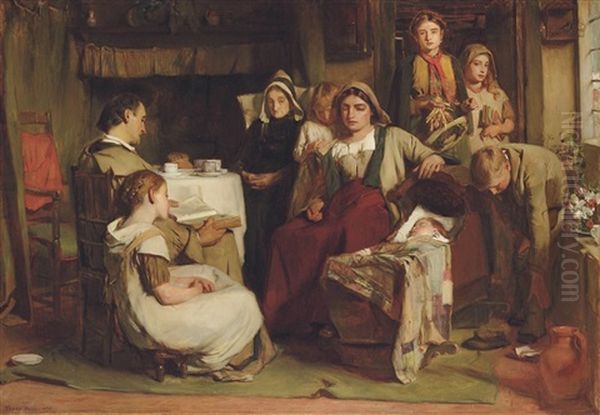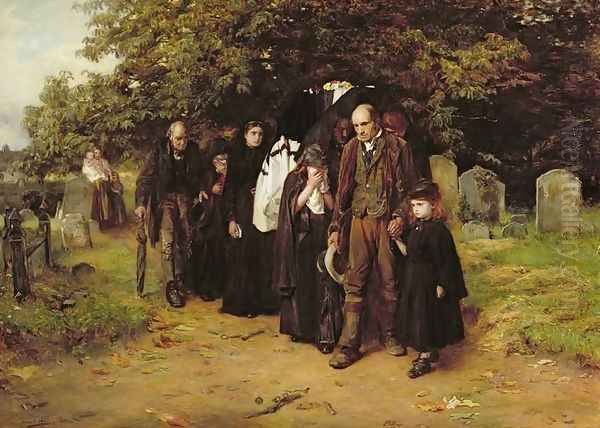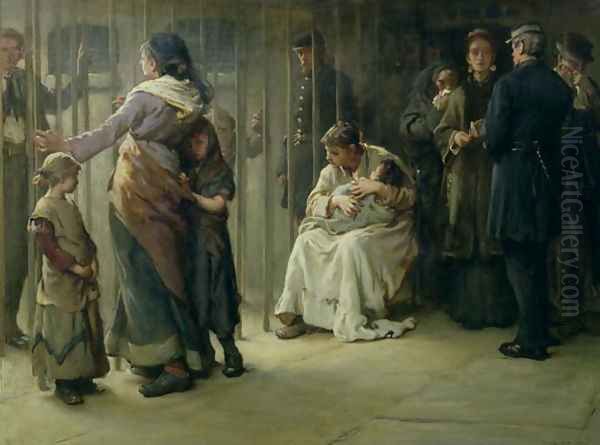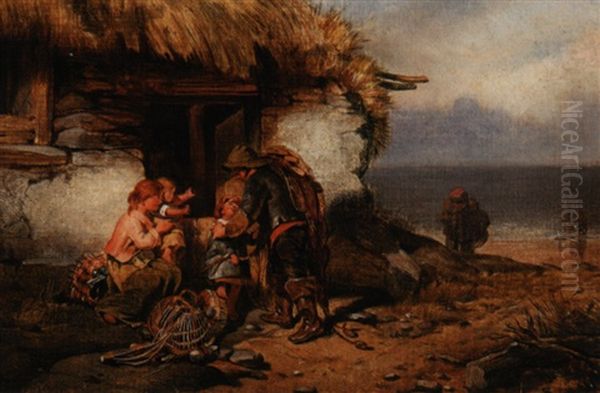Frank Holl stands as a significant, if sometimes overlooked, figure in the landscape of 19th-century British art. Born into an era of immense social change, industrial upheaval, and stark contrasts between wealth and poverty, Holl harnessed his considerable artistic talents to become a powerful visual chronicler of Victorian life. His work, particularly in his earlier career, resonated with a profound social conscience, capturing the pathos and struggles of the less fortunate. Later, he would become one of the most sought-after portraitists of his day, yet the somber intensity that characterized his genre paintings often imbued his likenesses with a unique psychological depth. This exploration delves into the life, artistic evolution, key works, and lasting legacy of Francis Montague Holl, known to the art world as Frank Holl.
Early Life and Artistic Awakening
Francis "Frank" Holl was born in Kentish Town, London, on July 4, 1845, into a lineage steeped in artistic tradition. He was the son of the distinguished engraver Francis Holl ARA (Associate of the Royal Academy), who himself came from a family of engravers. This familial environment undoubtedly nurtured young Frank's artistic inclinations from an early age. His grandfather, William Holl the Elder, and his uncles, William Holl the Younger and Charles Holl, were all respected engravers, ensuring that the principles of draughtsmanship, composition, and the meticulous rendering of form were part of his everyday upbringing.
Surrounded by the tools and discussions of the engraver's art, Holl demonstrated a precocious talent. Recognizing his potential, his family supported his artistic ambitions. At the tender age of fifteen, in 1860, he was admitted to the prestigious Royal Academy Schools. This institution was the crucible of British academic art, and entry was a significant step for any aspiring artist. Holl quickly distinguished himself among his peers, proving to be a diligent and gifted student.

His training at the Royal Academy Schools was rigorous, emphasizing classical principles, life drawing, and the study of Old Masters. During his time there, he garnered several accolades. In 1862, he received a silver medal for a drawing from the antique, and in 1863, he won a gold medal for historical painting with his work, Abraham's Sacrifice of Isaac (or Abraham about to Sacrifice Isaac). This early success with a religious theme was typical of academic training, but Holl would soon gravitate towards subjects more rooted in contemporary reality. He also received a two-year scholarship, further testament to his burgeoning abilities. His first exhibited works at the Royal Academy in 1864 included a portrait and a subject picture titled Turned out of Church, signaling his early interest in narrative and social observation.
The Rise of a Social Realist
The 1860s and 1870s saw Holl emerge as a prominent figure in the British Social Realist movement. This was not a formally organized group but rather a tendency among artists to depict the everyday lives and struggles of ordinary people, often focusing on the urban and rural poor. The Industrial Revolution had brought prosperity to some but also widespread poverty, harsh working conditions, and social dislocation, providing ample subject matter for artists with a social conscience. Holl, alongside contemporaries like Luke Fildes, Hubert von Herkomer, and Frederick Walker, turned his gaze to these often-unseen aspects of Victorian society.
His early genre paintings were characterized by their somber palettes, dramatic lighting reminiscent of Dutch Masters like Rembrandt, and a profound empathy for his subjects. Works such as The Ordeal (1869) and The Lord Gave and the Lord Hath Taken Away; Blessed be the Name of the Lord (1868), the latter exhibited at the Royal Academy in 1869, captured scenes of domestic grief and hardship with an unflinching honesty. The Lord Gave... depicted a humble cottage interior where a father comforts his wife over a deceased child, a scene of quiet devastation that resonated with Victorian sensibilities regarding family and mortality. This painting was sold for a respectable 250 guineas.
A pivotal moment in Holl's early career was his association with The Graphic, an illustrated weekly newspaper founded in 1869 by William Luson Thomas. Thomas aimed to create a publication that would use high-quality illustrations to report on contemporary events and social issues, often with a reformist agenda. He recruited a talented group of young artists, including Holl, Fildes, Herkomer, Sydney Prior Hall, and E.J. Gregory. For The Graphic, Holl produced powerful black-and-white illustrations that often served as studies or inspirations for his later paintings. These illustrations, designed for mass circulation, brought images of poverty and social distress to a wide audience, contributing to a growing awareness of these issues. His work for The Graphic honed his skills in narrative composition and capturing expressive human emotion.

One of his most celebrated early paintings, No Tidings from the Sea, was exhibited at the Royal Academy in 1871. It depicted a fisherman's wife and family anxiously gazing out at a stormy sea, a poignant portrayal of the anxieties faced by coastal communities. The painting was commissioned by Queen Victoria herself, who was deeply moved by a print of the subject she had seen. She purchased the oil painting for 100 guineas, a significant endorsement that greatly enhanced Holl's reputation. This work, with its themes of loss, waiting, and the precariousness of life, became an iconic image of Victorian social realism.
Other notable works from this period include Better is a Dinner of Herbs where Love is, than a Stalled Ox and Hatred therewith (1870), which, despite its somewhat moralizing title drawn from Proverbs, depicted a scene of quiet domesticity in poverty. While some critics found its tone overly somber, it showcased Holl's technical skill. Leaving Home (1873) and Deserted (1874) continued to explore themes of separation, loss, and vulnerability. Deserted (1874), showing a mother and child abandoned on the Embankment, was a particularly powerful piece that sold for 800 guineas, Holl's highest price for such a work.
Mastering the Human Condition: Key Thematic Works
Frank Holl's commitment to social realism was not merely a stylistic choice; it was deeply rooted in a humanitarian concern for the subjects he portrayed. His paintings from the 1870s, in particular, stand as powerful testaments to the harsh realities faced by many in Victorian England. He did not shy away from depicting grief, despair, and injustice, but he did so with a dignity that ennobled his subjects rather than merely sensationalizing their plight.
Newgate: Committed for Trial (1878) is arguably one of his most impactful social realist works. Exhibited at the Royal Academy, it shows a group of individuals in the grim interior of Newgate Prison, awaiting trial. The central focus is a respectable-looking man being comforted by his distraught wife, while other figures – a hardened criminal, a grieving mother, an innocent child – complete the scene of human misery. Holl's portrayal is not judgmental but rather observational, highlighting the emotional toll of the justice system on families. The painting was widely acclaimed for its dramatic intensity and psychological insight, and its depiction of the "respectable poor" caught in the cogs of the law was particularly resonant.

The Firstborn (1876) is another deeply moving work, depicting a young couple carrying the small coffin of their first child through a bleak, wintry landscape to a village graveyard. The raw grief of the figures, set against the desolate scenery, creates an image of profound sorrow. Holl's ability to convey such intense emotion through subtle gestures and expressions was a hallmark of his style. This painting, like many of his works, drew on the Victorian preoccupation with childhood mortality, a common tragedy in an era before modern medicine.
His painting I am the Resurrection and the Life (1872) also deals with the theme of death, but with a more overtly religious framing. It shows a graveside scene, likely a funeral, with mourners gathered around an open grave as a clergyman reads from the scriptures. The somber tones and the varied expressions of grief among the figures create a powerful sense of communal sorrow and spiritual contemplation.
Even in works with less overtly tragic themes, a sense of melancholy often pervaded. Hush (1877) and Hushed (1877) (the latter exhibited at the RA) depict quiet, contemplative domestic scenes, but the subdued lighting and pensive expressions of the figures suggest underlying anxieties or sorrows. The Foundling (1869) and The Seamstresses (date uncertain, now in the National Galleries of Scotland, formerly Royal Scottish Museum) also addressed the vulnerability of women and children in Victorian society.
Holl's social realist paintings were often compared to the work of French Realists like Gustave Courbet and Jean-François Millet, though Holl's approach was perhaps less overtly political and more focused on individual human drama and pathos. His work also shared affinities with Scottish artists like Thomas Faed and Erskine Nicol, who depicted scenes of rural life and poverty with a similar blend of realism and sentiment. The influence of Dutch Golden Age painting, particularly the work of Rembrandt and Jozef Israëls (a contemporary Dutch artist whose work Holl admired), is evident in his use of chiaroscuro and his focus on the dignity of ordinary people.
In 1868, Holl won the Royal Academy's prestigious two-year travelling scholarship. He intended to travel extensively in Europe, and did spend some time in Italy. It is said that while there, he was particularly impressed by the works of the Spanish master Diego Velázquez. However, his travels were cut short due to ill health, a recurring issue that would plague him throughout his relatively short life. He returned to England and continued to develop his distinct artistic voice.
A Shift Towards Portraiture

By the late 1870s and increasingly into the 1880s, Frank Holl began to shift his focus from social realist genre scenes to portraiture. This transition was driven by several factors. Portraiture was generally more lucrative than genre painting, and Holl, now married with a growing family, likely felt the need for greater financial stability. Furthermore, the intense emotional engagement required for his social realist subjects was reportedly taking a toll on his health and spirits. His daughter, in a later biography, noted that her father found the depiction of such sorrowful scenes deeply taxing.
However, Holl did not abandon his characteristic style when he turned to portraiture. His portraits are notable for their psychological depth, their often somber and introspective mood, and their powerful characterization. He brought the same intensity and empathy that marked his genre paintings to his depictions of individuals. He quickly became one of the most sought-after portrait painters in England, his services in high demand among the prominent figures of the day.
His sitters included leading politicians, churchmen, artists, writers, and members of the aristocracy. Among his most famous portraits are those of William Ewart Gladstone, the Prime Minister; John Bright, the statesman; Lord Spencer; Lord Overstone; and Field Marshal Viscount Wolseley. He also painted fellow artists, such as John Everett Millais (who himself had transitioned from Pre-Raphaelitism to highly successful portraiture and genre scenes) and Samuel Cousins, the renowned mezzotint engraver (a portrait from 1878). His portrait of Cousins is particularly noteworthy, given Holl's own family background in engraving.
Holl's portrait style was direct and unflattering, focusing on capturing the essential character of the sitter rather than idealizing them. He often used dark backgrounds and strong lighting to model the features, creating a sense of gravitas and introspection. This approach contrasted with the more flamboyant style of some of his contemporaries, such as John Singer Sargent, whose career was beginning to flourish as Holl's was nearing its end. While Sargent often emphasized a sitter's elegance and social standing, Holl delved into their inner life, sometimes revealing a sense of weariness or the burdens of office. His portraits of men, in particular, were praised for their strength and insight.
He was elected an Associate of the Royal Academy (ARA) in 1878, a testament to his growing reputation, and a full Royal Academician (RA) in 1883. These honors solidified his position within the British art establishment. Despite his success as a portraitist, some critics, both then and later, lamented his move away from social realism, feeling that his unique voice in that genre was a significant loss.
Artistic Style and Influences
Frank Holl's artistic style, while evolving, retained certain core characteristics throughout his career. His early training in engraving, inherited from his family, likely contributed to his strong sense of line and form, even in his painterly works. His compositions were carefully constructed, often with a focus on a central dramatic moment or a key psychological interaction between figures.
His color palette was generally subdued, favoring browns, grays, blacks, and muted earth tones, especially in his social realist works. This somber palette contributed to the melancholic and serious mood of his paintings. When he did use brighter colors, they were often employed strategically to draw attention to a particular detail or to create a specific emotional effect. His handling of paint could be vigorous and expressive, particularly in his later portraits, but he always maintained a strong sense of realism.
The influence of 17th-century Dutch painting, especially Rembrandt, is undeniable in Holl's work. He shared Rembrandt's interest in the psychological portrayal of subjects, his use of dramatic chiaroscuro (the contrast of light and dark), and his ability to find dignity and humanity in ordinary people. The work of the 19th-century Dutch painter Jozef Israëls, a leading figure of the Hague School, also resonated with Holl. Israëls, like Holl, depicted scenes of peasant and fisherfolk life with empathy and a similar somber realism.
While in Italy, Holl was reportedly impressed by Velázquez, and some of the Spanish master's directness and psychological acuity can be discerned in Holl's portraiture. Although the social realist movement in Britain developed somewhat independently, there were parallels with the Realist movement in France, led by artists like Gustave Courbet and Jean-François Millet. These artists also rejected academic idealism in favor of depicting contemporary life and labor, though their political undertones were often more pronounced.
Holl was also part of a broader Victorian visual culture that included illustration. His work for The Graphic was significant, and the discipline of creating effective black-and-white compositions for reproduction likely influenced his painting. Other illustrators of the period, such as Gustave Doré, whose depictions of London poverty were widely known, contributed to the visual language of social commentary.
Critical Reception and Contemporary Standing
During his lifetime, Frank Holl achieved considerable success and recognition. His social realist paintings, while sometimes criticized for their unrelenting gloom, were often praised for their power and sincerity. Works like No Tidings from the Sea and Newgate were popular at Royal Academy exhibitions and were widely reproduced as prints, reaching a broad public. His election as an ARA and then an RA confirmed his status within the art world.
His portraits were highly sought after, and he commanded substantial fees. Sitters and critics alike admired his ability to capture a likeness that was not merely superficial but seemed to reveal the sitter's character. However, the sheer volume of portrait commissions he undertook in his later years contributed to his overwork and declining health.
One of the most notable admirers of Holl's work was Vincent van Gogh. During his time in London (1873-1876) and later through prints, Van Gogh became deeply familiar with the work of British social realist illustrators and painters, including Holl, Fildes, and Herkomer. He collected their prints from The Graphic and other publications and frequently mentioned them with admiration in his letters to his brother Theo. Van Gogh saw in their work a genuine concern for humanity and a powerful depiction of the lives of the poor, qualities that he himself sought to express in his own art. He considered Holl one of the finest artists in England, praising the emotional depth and truthfulness of his work.
Compared to his close contemporaries Luke Fildes and Hubert von Herkomer, Holl's social realism was perhaps the most consistently somber and intense. Fildes, while also tackling difficult subjects (e.g., Applicants for Admission to a Casual Ward), later moved towards more opulent society portraits and Venetian scenes. Herkomer had a more varied career, encompassing social realism (e.g., On Strike), portraiture, and even pioneering work in filmmaking. All three, however, played a crucial role in bringing social issues to the forefront of British art in the mid-Victorian period.
The Toll of Dedication: Later Years and Premature Death
Frank Holl's dedication to his art was immense, but it came at a significant personal cost. He was known for his intense work ethic, often laboring for long hours in his studio, particularly when facing deadlines for portrait commissions. This relentless pace, combined with a pre-existing susceptibility to illness (possibly a congenital heart condition, as suggested by some sources), took a severe toll on his health.
The emotional intensity of his early social realist subjects had already been draining. While portraiture might have seemed less emotionally demanding, the pressure to satisfy prominent clients and the sheer number of commissions he accepted created its own stresses. His health began to seriously decline in the mid-1880s.
Despite his failing health, Holl continued to work. He had moved to a new, larger house in Fitzjohn's Avenue, Hampstead, which included a spacious studio, but he had little time to enjoy it. His final years were marked by increasing illness and exhaustion. Frank Holl died on July 31, 1888, at the tragically young age of 43. His death was officially attributed to "overwork," a poignant reflection of his unwavering commitment to his profession. His passing was widely mourned in the art world, recognized as the loss of a major talent.
Legacy and Enduring Impact
Frank Holl left behind a significant body of work that continues to command respect. His social realist paintings are valued for their powerful and empathetic portrayal of Victorian society, offering a crucial visual counterpoint to the more triumphalist narratives of the era. They provide invaluable insights into the lives, struggles, and emotional worlds of ordinary people, particularly the poor and marginalized. Works like Newgate, No Tidings from the Sea, and The Firstborn remain compelling for their artistic skill and their profound humanism.
His portraits, while perhaps less innovative than his genre scenes, are nonetheless important examples of late Victorian portraiture, characterized by their psychological depth and sober realism. They provide a fascinating gallery of the leading figures of his time.
Holl's influence can be seen in the work of subsequent artists who engaged with social themes. His admirer, Vincent van Gogh, absorbed lessons from the British social realists, which informed his own depictions of peasant life and labor. While social realism as a distinct movement waned in the late 19th and early 20th centuries with the rise of modernism, the concern for social justice and the depiction of everyday life continued in various forms.
Today, Frank Holl's paintings are held in major public collections in the United Kingdom and beyond, including Tate Britain (London), the National Portrait Gallery (London), the Walker Art Gallery (Liverpool), Manchester Art Gallery, and the National Galleries of Scotland (Edinburgh). The Royal Collection also holds important works, notably No Tidings from the Sea. His work is periodically featured in exhibitions focusing on Victorian art and social realism, allowing new generations to appreciate his contribution.
While perhaps not as widely known today as some of his contemporaries like Millais or the Pre-Raphaelites such as Dante Gabriel Rossetti or William Holman Hunt, Frank Holl's art remains a vital part of the story of 19th-century British painting. He was an artist of great skill and profound empathy, who used his talents to bear witness to the human condition in all its complexity, from the quiet despair of a bereaved family to the dignified bearing of a national leader. His legacy is that of an artist who truly was a conscience in paint for the Victorian age, leaving behind images that continue to speak to us of shared human experiences. His ability to connect with the emotional core of his subjects, whether in a crowded prison waiting room or a stately portrait setting, ensures his enduring relevance. The art world also remembers figures like William Powell Frith for his panoramic social scenes, or George Frederic Watts for his allegorical and portrait works, but Holl carved a unique niche with his intense, focused human dramas. His early death undoubtedly cut short a career that might have evolved in further interesting directions, but the work he did produce remains a powerful and moving testament to his talent and his times.